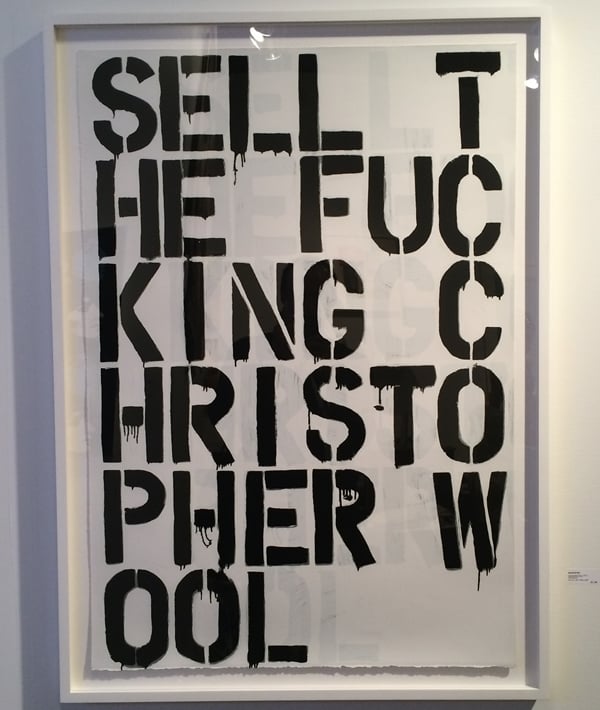
Photo: Benjamin Sutton.
In a lengthy Bloomberg Businessweek story that has an astounding level of detail about private sale prices and the inner workings of the contemporary art market, writers Vernon Silver and James Tarmy track the path of Christopher Wool’s most famous painting, Apocalypse Now, from its creation in 1988 to its eye-popping $26.5 million price at auction 25 years later, at Christie’s in November 2013.
As the writers state: “The journey of Apocalypse Now to the biggest night the auction world had ever seen is the story of the contemporary art market’s unprecedented rise and the forces behind it.” (An added bonus here are the hilarious original illustrations by Aisha Franz depicting poodles, birds, rabbits, penguins, dogs, and crocodiles alternately admiring and trading the painting. The painting itself is not reproduced in the story. Perhaps that is because Wool is notoriously fickle about allowing reproductions of his work.)
But what really stands out is the level of detail about the price points at which the painting—which takes its line from the same-named movie and has Wool’s signature black-and-whiteblock text that reads “SELL THE HOUSE SELL THE CAR SELL THE KIDS”—changed hands among some of the world’s top collectors in a chain of sales negotiated by private dealers and auction houses. We’re still scratching our heads figuring out the how and why behind normally extremely tight-lipped power players like Philippe Ségalot and Per Skarstedt revealing the actual dollar amounts behind the deals they negotiated for collectors including the late Elaine Dannheisser and Christie’s owner François Pinault. Perhaps because it was so long ago?
The painting was owned by Dannheisser and her husband Werner Dannheisser, who passed away in 1992. Elaine gave most of her collection to the Museum of Modern Art in 1996. But, in one of those face-palm-in-retrospect moments, the museum turned down Apocalypse Now because “they already had a Christopher Wool, and they thought they didn’t need two,” as Ségalot recounts.
Dannheisser then consigned it to Christie’s (where Ségalot was head of the contemporary art department at the time) which placed a $60,000 estimate on it. But that sale was forfeited when dealer Skarstedt swooped in with a private sale offer “between $100,000 and $150,000” and offered to auction his own Wool, Fool, instead.
Dannheisser was left feeling like the fool when Fool—widely considered less important than Apocalypse Now—soared to $420,500 on a low estimate of $40,000. Ségalot told Bloomberg that Dannheisser, who was sitting in the saleroom watching as the price soared, didn’t speak to him for six months.
In short order, Skarstedt sold the painting to Gap founder Donald Bryant for about $400,000. But when his wife objected to the decidedly anti-family value content of the text, Ségalot found another buyer Pinault, who bought the work, also for around $400,000. In 2005, Pinault, who likes to collect in depth, decided he didn’t want to own just one Wool and sold the painting to hedge fund titan David Ganek for $2 million.
It was due to be a marquee work at the Guggenheim’s much-lauded 2013–2014 Wool retrospective, but was yanked from the exhibition when it was revealed that Christie’s was selling the work at its upcoming November contemporary auction.
Here is where Bloomberg’s report differs from the art world scuttlebutt about the painting when news of the consignment emerged in October 2013. According to the Bloomberg story: “The first news that the Ganeks had sold—to a still unknown party—came on Oct. 4, 2013 in the form of a Christie’s press release.” But, according to Judd Tully, writing for Artinfo at the time: “It is understood that Ganek made the private deal with Christie’s.”
In a somewhat surreal end note, the story recounts that Wool attended the opening of the retrospective when it traveled to the Art Institute of Chicago, which, unlike the Guggenheim, included Apocalypse Now. Wool spoke with Christophe Van de Weghe, who had bid for the still unidentified $26.5 million collector. Wool, who is notoriously particular about his work and never gives interviews, reportedly said to Van de Weghe: “I would love to know who the owner is. I would love to know who owns my work.”
artnet News has previously reported on Wool’s market and the recent spikes (see “Millionaires Love Richard Prince and Christopher Wool” and “Art Market Analysis: Richard Prince vs. Christopher Wool at Auction“)